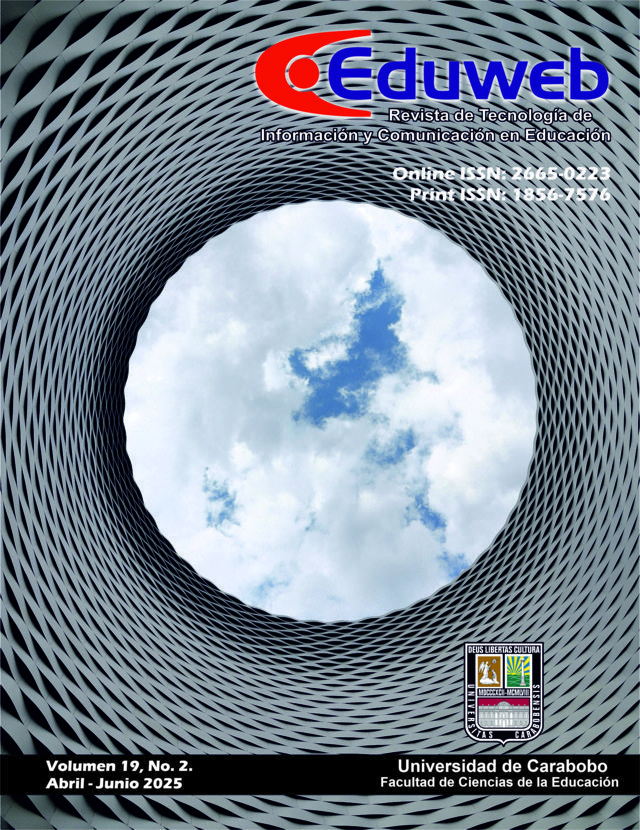Use of information technologies in learning among graduate students
DOI:
https://doi.org/10.46502/issn.1856-7576/2025.19.02.10Keywords:
information and communication technologies, learning tools, studentsAbstract
This research aimed to analyze ICTS as a learning tool among Obstetrics and Gynecology graduate students at the Enrique Tejera Hospital City. The study used a descriptive, quantitative approach and a non-experimental field design. The population consisted of 42 graduate student residents. The sample was census-based. A survey was used to collect data, and a questionnaire with fourteen (14) dichotomous questions was developed as an instrument. Experts validated the questionnaire, and the Kuder-Richardson coefficient was used for reliability. The result was 0.73. The information was analyzed using descriptive statistics, leading to the conclusion that ICTs as a learning tool among Obstetrics and Gynecology graduate students at the University of Chechnya (CHEC) are widely used to access study materials, participate in courses and webinars, and collaborate in academic communities, improving interaction between students and faculty and fostering collaborative learning. However, challenges persist regarding technological access and skills, highlighting the need to enhance digital competencies.
References
Burgos Aguilar, J. (2007). El reto de la radio interactiva y la tutoría virtual. En A. Lozano y B. Vladimir, Tecnología Educativa en un Modelo de Educación a Distancia Centrado en la Persona (pp. 241-276). México: Limusa.
Cabero-Almenara, J. (2020). Tecnología y enseñanza: retos y nuevas tecnologías y metodologías. CITAS, 6(1). Recuperado de: https://doi.org/10.15332/24224529.6356
Casillas, J., & Gremeaux, V. (2012). Evaluation of medical students’ expectations for multimedia teaching materials: Illustration by an original method using the evaluation of a web site on cardiovascular rehabilitation. Annals of Physical and Rehabilitation Medicine, 55(1), 25- 37. https://doi.org/10.1016/j.rehab.2011.12.001
Cobo, A. (2009). Uso de la Computadora en el Salón de Clase. España: Editorial 2010.
Chinchay-Vergara, M. (2021). Rol del aprendizaje activo en la educación médica durante la COVID-19. Investigación En Educación Médica, 10(39), 106-107. https://doi.org/10.22201/fm.20075057e.2021.39.21364
Davenport, T. H., & Prusak, L. (1999). Working Knowledge: how organisations manage what they know. Boston: Harvard University Press.
Davis, N. (2020). The Globalisation of Education Through Teacher Education with New Technologies: A View Informed by Research Through Teacher Education with New Technologies. AACE Review (formerly AACE Journal), 8-12. https://www.learntechlib.org/primary/p/8116/
Echeverría, J. (2003). La revolución tecnocientífica. Madrid: Fondo de Cultura Económica.
Garcés Prettel, M., & Ruiz Cantillo, R. (2016). Integración pedagógica de la tecnología informática en instituciones educativas oficiales de Cartagena de indias (Colombia). Saber, Ciencia Y Libertad, 11(1), 175-186. https://doi.org/10.18041/2382-3240/saber.2016v11n1.502
Hernández Sampieri, R., Fernández Collado, C., & Baptista Lucio, P. (2008). Metodología de la Investigación. México: McGraw-Hill.
Kortabitarte, A., Gillate, I., Luna, U., & Ibáñez‐Etxeberria, A. (2018). Las aplicaciones móviles como recursos de apoyo en el aula de Ciencias Sociales: estudio exploratorio con el app “Architecture gothique/romane” en Educación Secundaria. Ensayos, Revista de la Facultad de Educación de Albacete, 33(1). http://www.revista.uclm.es/index.php/ensayos
Linares Pons, N., Verdecia Martínez, E. Y., & Álvarez Sánchez, E. A. (2014). Tendencias en el desarrollo de las TIC y su impacto en el campo de la enseñanza. Revista Cubana de Ciencias Informáticas, 8(1),127-139. https://www.redalyc.org/articulo.oa?id=378334195008
López-Catalán, L., López-Catalán, B., & Delgado-Vázquez, Á. M. (2019). Promoción web, innovación y programas de postgrado en e-learning. International Journal of Educational Research and Innovation (IJERI), 11, 47-59. https://scispace.com/pdf/web-promotion-innovation-and-postgraduate-e-learning-2vpsdwn8ez.pdf
Pérez Alcalá, M. D. S., Ortiz Ortiz, M. G., & Flores Briseño, M. M. (2015). Redes sociales en Educación y propuestas metodológicas para su estudio. Ciencia, docencia y tecnología, (50), 188-206. https://www.scielo.org.ar/pdf/cdyt/n50/n50a08.pdf
Riviére, A. (2002). La psicología de Vygotsky. Madrid: Aprendizaje Visor.
Sánchez Cortés, R., García Manso, A., Allende, J., & Díaz & Reinoso, A. (2015). B-Learning y Teoría del Aprendizaje Constructivista en las Disciplinas Informáticas: Un esquema de ejemplo a aplicar. Recent Research Development Sin Learning Technologies, 1-6. http://wiki.gita.cl/lib/exe/fetch.php?media=info3x1:aprendizaje.constructivista
Sánchez-Trujillo, M. de los A., Bernabé-Sánchez, E., Sáenz-Egúsquiza, F.D., & Rodríguez-Flores, E.A. (2024). Uso del portafolio virtual para la gestión del aprendizaje de estudiantes de postgrado. Revista Eduweb, 18(4),150-164. https://doi.org/10.46502/issn.1856-7576/2024.18.04.10
UNESCO (2023). Reforzar el aprendizaje y las capacidades digitales en los países más poblados del mundo para estimular la recuperación de la educación. https://acortar.link/j8JP0Y
Vidal del Toro, H., Ramírez Roger, M., Ruiz Santana, Y., & Pérez de la Rosa, M. (2015). Introducción de las TIC en el proceso enseñanza-aprendizaje en el sector salud. Revista información científica, 91(3), 679-691. https://revinfcientifica.sld.cu/index.php/ric/article/view/570/1360
Published
How to Cite
Issue
Section
License
Copyright (c) 2025 Evelio Duque, Nelly Medina, María Navarro, Marisol Rodríguez

This work is licensed under a Creative Commons Attribution 4.0 International License.














